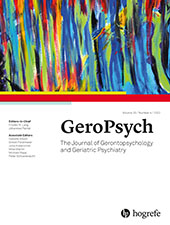Pet Ownership and the Future Time Perspective of Older Adults
Abstract
Abstract. Time perspectives may change as people age and become more aware of their limited time remaining in life. A research question is whether awareness of one’s limited time remaining associates with pet ownership among older adults. Although owning pets in old age involves both benefits and risks, the association between pet ownership and subjective remaining time in life remains understudied. The present study examines the associations between pet ownership and the subjective perception of time remaining in life among older adults. We assessed the experience of pet ownership (dog or cat) and age-related future time perspectives of 329 community-dwelling older adults in Japan. By adopting three constructs of the Future Time Perspective scale, we found that current dog ownership was associated with more limited future opportunities but not with limited time left or future constraints. Older dog owners may focus on the present rather than new future opportunities, yet they may see the future of their dogs that require care. Yet no such association was observed among current cat owners. The present findings extend the previous research of age-related future time perspectives by suggesting that pet ownership in late adulthood may be another contributing factor that needs to be better understood.
References
(2018). Ageism affects older adults’ future time perspective. GeroPsych, 31, 115–126. https://doi.org/10.1024/1662-9647/a000189
(1991). The Short Form of the Geriatric Depression Scale: A comparison with the 30-Item form. Topics in Geriatrics, 4(3), 173–178. https://doi.org/10.1177/089198879100400310
(2006). The influence of a sense of time on human development. Science, 312(5782), 1913–1915. https://doi.org/10.1126/science.1127488
(1996). Future Time Perspective Scale (Unpublished manuscript). Stanford University.
(2003). Aging, emotion, and evolution: The bigger picture. Annals of the New York Academy of Sciences, 1000, 152–179. https://doi.org/10.1196/annals.1280.008
(2020). Age advantages in emotional experience persist even under threat from the COVID-19 pandemic. Psychological Science, 31(11), 1374–1385. https://doi.org/10.1177/0956797620967261
(2007). Testing models of the structure and development of future time perspective: Maintaining a focus on opportunities in middle age. Psychology and Aging, 22, 186–201. https://doi.org/10.1037/0882-7974.22.1.186
(2011). Being well as time goes by: Future time perspective and well-being. International Journal of Psychology & Psychological Therapy, 11(2), 219–232.
(2010). Awareness of age-related change: Examination of a (mostly) unexplored concept. Journals of Gerontology, Series B: Psychological Sciences and Social Sciences, 65B(3), 340–350. https://doi.org/10.1093/geronb/gbp110
(2019). Pet ownership and human–animal interaction in an aging population: Rewards and challenges. Anthrozoös, 32(2), 255–265. https://doi.org/10.1080/08927936.2019.1569907
(2006). Goals change when life’s fragility is primed: Lessons learned from older adults, the September 11 attacks and SARS. Social Cognition, 24(3), 248–278. https://doi.org/10.1521/soco.2006.24.3.248
(2016). The limits of a limited future time perspective in explaining age differences in emotional functioning. Psychology and Aging, 31(6), 583–593. https://doi.org/10.1037/pag0000060
(2020). How do cat owners, dog owners and individuals without pets differ in terms of psychosocial outcomes among individuals in old age without a partner? Aging and Mental Health, 24(10), 1613–1619. https://doi.org/10.1080/13607863.2019.1647137
(2020). Pet ownership and its influence on mental health in older adults. Aging and Mental Health, 24(10), 1605–1612. https://doi.org/10.1080/13607863.2019.1633620
(2013). Mirai tenbou shakudo no sakusei: Future Time Perspective Scale Nihongo ban
[Development of Japanese version of Future Time Perspective Scale] . Journal of Gerontological Research, 4, 1–9.(2021). Association between experience of pet ownership and psychological health among socially isolated and non-isolated older adults. Animals: An Open Access Journal From MDPI, 11(3), Article
595 . https://doi.org/10.3390/ani11030595. (2020, December 23). Nen zenkoku inu neko shiiku jittai tyousa kekka
[Results of the 2020 national dog and cat ownership survey] . https://petfood.or.jp/topics/img/201223.pdf(2011). How changes in subjective general health predict future time perspective, and development and generativity motives over the lifespan. Journal of Occupational and Organizational Psychology, 84(2), 228–247. https://doi.org/10.1111/j.2044-8325.2010.02012.x
(2019). Dogs have masters, cats have staff: Consumers’ psychological ownership and their economic valuation of pets. Journal of Business Research, 99, 306–318. https://doi.org/10.1016/j.jbusres.2019.02.057
(2019, October 29). Seimei hoken wo pet ni nokosu
[Leave life insurance money on pets] . Nishi Nihon Shinbun. https://www.nishinippon.co.jp/item/n/554972. (2021, January 12). Pet ownership in Japan on the rise amid COVID-19 pandemic. Kyodo News. https://english.kyodonews.net/news/2021/01/c6788162c7b5-feature-pet-ownership-in-japan-on-the-rise-amid-covid-19-pandemic.html
(2000). Endings and continuity of social relationships: Maximizing intrinsic benefits within personal networks when feeling near to death. Journal of Social and Personal Relationships, 17(2), 155–182. https://doi.org/10.1177/0265407500172001
(2002). Time counts: Future time perspective, goals, and social relationships. Psychology and Aging, 17(1), 125–139. https://doi.org/10.1037/0882-7974.17.1.125
(2018). Future time perspective: Time horizons and beyond. GeroPsych, 31(3), 163–167. https://doi.org/10.1024/1662-9647/a000194
(2004). Socioemotional selectivity theory, aging, and health: The increasingly delicate balance between regulating emotions and making tough choices. Journal of Personality, 72(6), 1395–1424. https://doi.org/10.1111/j.1467-6494.2004.00301.x
(2021, March 22). One in 10 older adults have gotten a “pandemic pet,” poll finds (News release). University of Michigan-Michigan Medicine. https://ihpi.umich.edu/news/one-10-older-adults-have-gotten-pandemic-pet-poll-finds
(2012). The Hatoyama Cohort Study: Design and profile of participants at baseline. Journal of Epidemiology, 22(6), 551–558. https://doi.org/10.2188/jea.JE20120015
(2020). Why did I share my life with Glucio? A life course approach to explaining pet ownership motivations in late adulthood. Anthrozoös, 33(1), 89–102. https://doi.org/10.1080/08927936.2020.1694314
(2017). A three-component model of future time perspective across adulthood. Psychology and Aging, 32(7), 597–607. https://doi.org/10.1037/pag0000191
(2020). Differences in self-esteem between cat owners, dog owners, and individuals without pets. Frontiers in Veterinary Science, 7, Article
552 . https://doi.org/10.3389/fvets.2020.00552(2015). Reference values and age differences in body composition of community-dwelling older Japanese men and women: A pooled analysis of four cohort studies. PLoS One, 10(7), Article
e0131975 . https://doi.org/10.1371/journal.pone.0131975. (2019). Stata Statistical Software: Release 16.
(2018). Physical, social, and psychological characteristics of community-dwelling elderly Japanese dog and cat owners. PLoS One, 13(11), Article
e0206399 . https://doi.org/10.1371/journal.pone.0206399(2019). Association of dog and cat ownership with incident frailty among community-dwelling elderly Japanese. Scientific Reports, 9(1), Article
18604 . https://doi.org/10.1038/s41598-019-54955-9(2022). Evidence that dog ownership protects against the onset of disability in an older community-dwelling Japanese population. PLoS One, 17(2), Article
e0263791 . https://doi.org/10.1371/journal.pone.0263791(2013). Attachment in old age: Theoretical assumptions, empirical findings and implications for clinical practice. Clinical Psychology Review, 33(1), 67–81. https://doi.org/10.1016/j.cpr.2012.10.003


